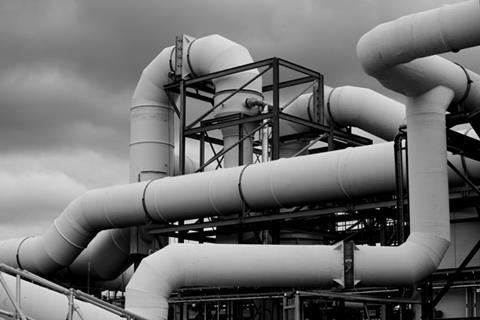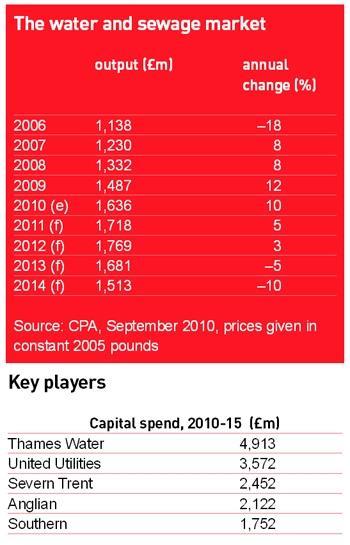With regulation driving investment and resource efficiency in the waste and water sectors, Matthew Hicks and Andrew Wheeler of Davis Langdon examine how the UK’s obligations are going to be met, and what the opportunities are for consultants and contractors

Water and waste are going to become vital to the construction industry over the next decade. The water sector is going to attract investment worth £22bn between now and 2015 and the amount to be spent on waste over 10 years is estimated to be somewhere between £10bn (UK Trade & Investment’s estimate) and £30bn (the Institution of Civil Engineers’ estimate). But as there will also be a squeeze on costs, new regulation, contentious planning issues and a struggle to manage risk, the challenge is to deliver efficient and profitable services in return for this money.
Funding and investment in waste
Waste treatment has been designed around collection, haulage and landfill. In recent years, central and local government have tried to improve recycling rates, and treatment facilities have expanded. EU rules and the impact of the landfill tax escalator mean that landfill is no longer an option for long-term waste disposal.
Although the exact sum is not clear, the public sector will have to invest somewhere between £9bn and £11bn in infrastructure if it is to meet the EU target of a 75% reduction in waste to landfill by 2020. However, given that a large proportion of waste schemes are not entirely publicly funded, output figures are not published and figures for the total investment in commercial and industrial waste infrastructure are often contradictory. In August 2010 it was reported that the top 10 waste management contracts yet to be awarded had a combined value of £9.5bn. The practicalities of implementation may prove a stumbling block as for most schemes, planning will continue to be contentious and high risk.
The key players
The main players within the waste management market have changed little in recent years.
| turnover £m | |
|---|---|
| Veolia Environmental | 1,232 |
| SITA UK | 717 |
| Biffa | 676 |
| Waste Recycling Group | 524 |
| Viridor | 523 |
| Cory Environmental | 202 |
| Shanks Group | 158 |
| SCA Recycling UK | 157 |
| Greenstar Holdings | 146 |
| LondonWaste | 84 |
These firms are investing time and capital in the procurement stages of PFI/PPP projects. However, several new entrants to the market are also looking to take advantage of waste infrastructure investment opportunity, such as Covanta, Urbaser, United Utilities, MVV Umwelt and AmeyCespa.
Merchant plant capacity is also a growth area for more speculative developers that can secure sufficient waste streams prior to committing to build. The landfill tax is an important driver as is the considerable capital required to build an energy from waste (EfW) plant, as waste companies cannot raise this capital against their balance sheet.
Despite the coalition government’s spending cuts in virtually every other area, significant cuts in waste infrastructure spending are unlikely because EU legislation is non-negotiable. However, it is not clear whether councils can continue to afford PFI/PPP projects, or whether merchant plant capacity could pick up shorter term contracts with more flexibility as a result.
Future opportunities
There is likely to be a big push towards anaerobic digestion in the next five years as the coalition is commited to promoting energy from waste plants. The Anaerobic Digestion and Biogas Association (ADBA) has said this could mean that as many as two plants are built each week over the next 10 years. These are likely to be small schemes, with an output of less than 5MW. The feed-in tariff scales will discourage the construction of larger facilities, as will technology risk, the capital required and the need to gain access to long-term waste streams.
Waste schemes are often procured using an engineer, procure and construct (EPC) contract; in other words, a contract to assess the scope of work required and deliver it. The EPC wrapper improves the bankability of the deal and so attracts senior debt - provided the EPC has a sufficiently large balance sheet to secure the lending against.
Therefore contractors need to target the most appropriate point of entry. For instance, a large contractor with a strong balance sheet could take the role of EPC contractor. It would enter into a contract with the technology provider and take on the performance risk. Other contractors may consider more downstream activities, such as the civil engineering and structural works required to deliver a facility. However, the size of the opportunity is heavily based on the technology deployed, as the EPC “wrap” is dependant on the design underwritten by the EPC contractor. This translates to a transfer of risk to subcontractors, which will need to price for the risk of non-compliant works.
Smaller scale plants, such as anaerobic digestion unit, would also need to be wrapped with an EPC. Owing to the smaller scale of plant, we may see more contractors entering the EPC marketplace. However they are likely to face stiff competition from anaerobic digestion technology providers from the US and Europe, so UK firms may have to move further down the supply chain.Consultants have a range of opportunities. They could work for waste management firms or energy developers, or support design-and-build contractors under the EPC contractor. Consultancies with a process engineering background may work with technology providers to improve the plant’s efficiency. Funders need to conduct due diligence on the investments they are considering, and local authorities will require technical and procurement advice.
merging technologies, such as plasma gasification, waste to biofuel and waste to fuel cells, are likely to form part of the portfolio of waste infrastructure. These technologies are alternatives to incineration, although there are few bankable suppliers with a reference project (that is, one that has clocked up 20,000 operational hours) and a balance sheet large enough to give comfort to a lender. And, as it is notoriously difficult to maximise the efficiency and effectiveness of new technologies, there is a significant operation and maintenance risk. In terms of planning, the key difference is the move from waste management to waste treatment that includes energy generation. This can slow down the planning application. There is unlikely to be a large scale deployment of these technologies for a number of years as there is no appetitive among investors for technology risk of any kind at the moment.
Sustainability and carbon reduction in the waste and water sectors
The UK water and waste markets will have to meet challenging carbon reduction targets. Carbon emissions must fall 34% by 2020 and 80% by 2050 (from 1990 levels). Schemes such as the carbon reduction commitment are creating an environment where the carbon performance of service providers will become an integral determinant of future competitiveness.
Achieving these cuts will require effort in two areas. As populations increase, so does demand for water and waste services. We need to counter this growth in demand through early intervention at the level of the consumer. There are already a number of organisations busy in this space. For example, Wrap’s combined strategy of encouraging less waste and promoting recycling tackles two issues in the waste sector. Similarly, organisations such as Waterwise are beginning to show results as solutions such as low flow taps become more common. But in neither case has the idea of resource efficiency become the status quo, leaving the sector a long way from where it needs to be. In short, this means that the energy and water sectors need to make the carrot more appetising or work harder with the stick to compensate for the inefficiencies of their customers.
The other key challenge is technological. Finding new ways to treat and distribute water and waste that achieves required levels of quality but reduced carbon impacts. In waste, this involves a sensible focus on the waste hierarchy - moving from reuse, to recycling and then energy recovery. Decarbonising water supply is a complex picture, with a number of possible intervention points. Greater use of sustainable urban drainage systems is certainly one way of limiting the pressure on the network. Exploring flexible treatment rates to coincide with the seasons and water levels in rivers is another, as is the possible decentralisation of treatment facilities to take advantage of local low-energy solutions.
Funding and investment in water
In April this year water companies began their fifth five-year asset management programme (AMP). In the previous four, more than £80bn was invested in England and Wales’ water and sewage system; this represents a quarter the entire infrastructure market and 2% of the overall construction market.
The 12 water and sewage and 10 water-only companies are embarking on an ambitious (albeit mandatory) investment programme. This will involve their biggest spend to date. It is, however, £5bn less than the water companies claimed they needed over the period. Set against a backdrop of a slow recovery in the UK market, Ofwat, the sector regulator, also determined that average household bills needed to remain at 2009 levels. The funding gap is, therefore, significant.
Every AMP cycle is different; AMP5 will deliver fewer major projects than AMP4, and the focus will be on maintaining existing assets.The private development market remains
subdued and the opportunity for water companies to develop outside the regulated framework is severely limited. “Can’t pay, won’t pay” customers remain a challenge for maintaining the balance between funding and investment as the strict governance of what sanctions can be used makes recouping unpaid bills an expensive and often fruitless exercise. In 2009, the Walker Review recommended that England and Wales should move to 80% metering by 2020. Although progress to date has been questionable, metering is likely
to continue to have a high profile over the next five years.
Future opportunities
A proven track record in the sector, or transferable experience, is vital. Contractors and consultants are procured under the EU Official Journal’s rules, so the process is not quick; the AMP5 procurement process began last year and a significant number of contracts have been awarded. The AMP6 procurement programme is likely to start in 2014.

The funding squeeze and lack of viable alternative sources of income means the delivery of AMP5 will require a new set of skills and a fresh approach if it is to be successful. As the water companies move to managing smaller overlapping projects, the programme management office (PMO) approach is coming to the fore. For example Northern Ireland Water is procuring consultant partners to join its PMO for the first regulated programme of investments. As efficiencies are driven into the process, there will be a greater reliance on those further down the supply chain.
There are likely to be smaller contracts running concurrently, with the PMO directly managing, controlling and reporting on their outputs. This will allow efficiency targets to run through the procurement process and provide opportunities to reduce costs. Volume purchases at lower tiers of the supply chain will mean there will be more direct contact between clients and the smaller subcontractors or suppliers. Efficiency will be the mantra throughout AMP5, as will strategic planning and the control of delivery. The emphasis will be on doing more with less and making the most of existing assets.
Spending is projected to grow by 3.5% a year from 2010 taking the total spend in 2014 to over
Opportunities exist for those that can deliver value through sustainability. The sector has been investing in renewable energy for some time, from hydroelectric generators to, more recently, Wessex Water’s use of methane as a fuel for its vehicles. AMP5 allows £57m for renewable energy projects, and these are forecast to deliver £8.8m of savings in operational expenditure when they are implemented.

Carbon reduction can also reduce operational spending through technologies such as sludge management, gasification of waste treatment discharges and pelletising; this has the additional benefit that it could reduce the burden of environmental taxes, levies or surcharges, such as the Carbon Reduction Commitment Scheme.
The adaptation of existing technology for new uses may be more advantageous for technology advancement. Progress has been made on the injection of biogas into the gas grid. The use of proven technology should offer greater cost efficiency and a faster speed to market.
As already mentioned, the investment community (both equity and debt) is wary of technology risk. The waste companies cannot leverage senior debt against their balance sheet and developers do not want to take the risk of sinking significant capital in a plant that is not fit for purpose. Funders can often be enticed into investing in emerging technologies only by
high internal rates of return or the willingness of an EPC contractor to take on performance risk.
To gain both of these can often be a challenge, and large-scale PFI/PPP procurement doesn’t often have a place for emerging technologies. In the most EfW schemes, planning will continue to be contentious and high risk. High operating costs mean government incentives (including landfill tax), renewable obligation certificates and feed-in tariffs will play a critical role if investors are to be attracted.
Downloads
Where the money will be spent
Other, Size 1.68 mb



























No comments yet